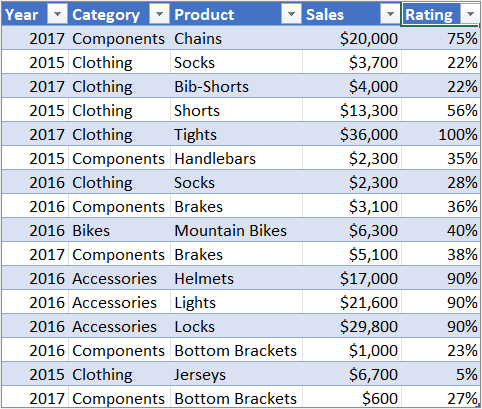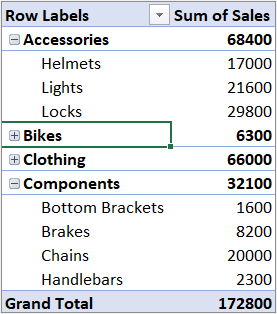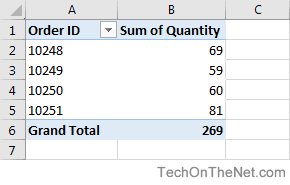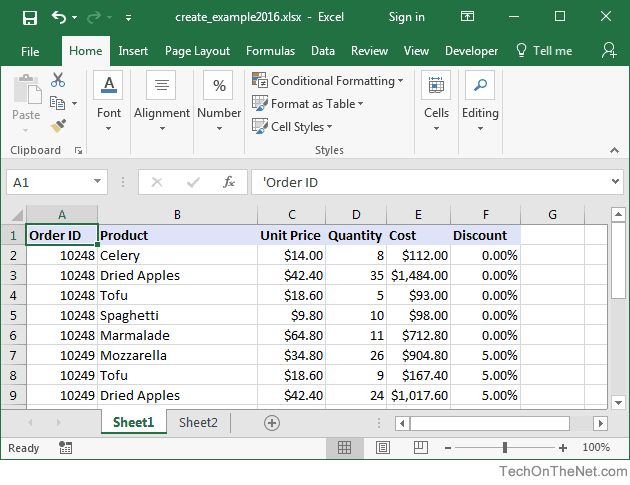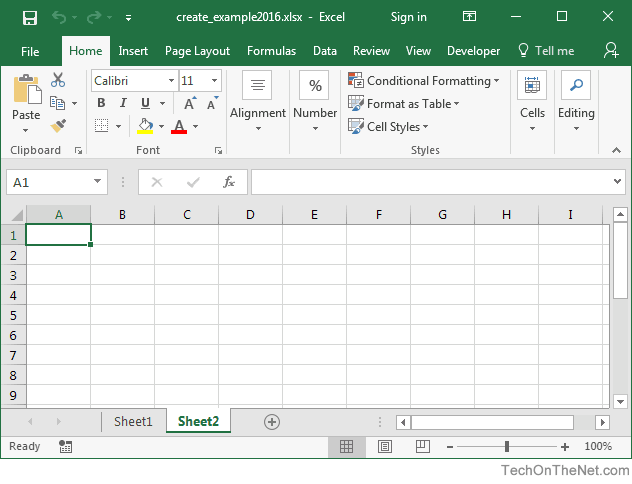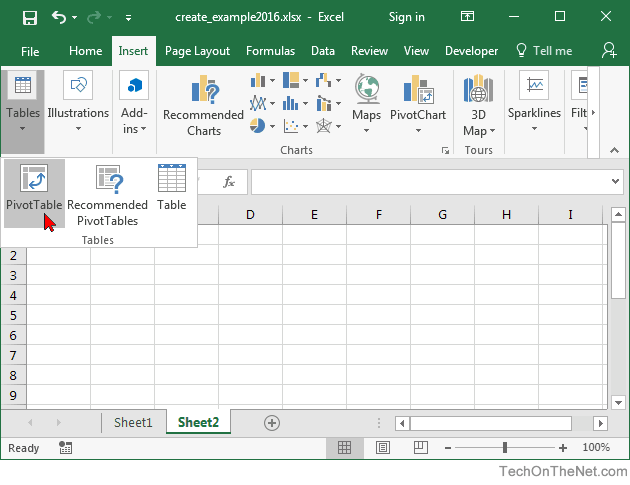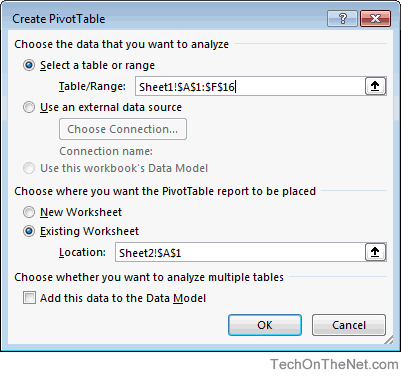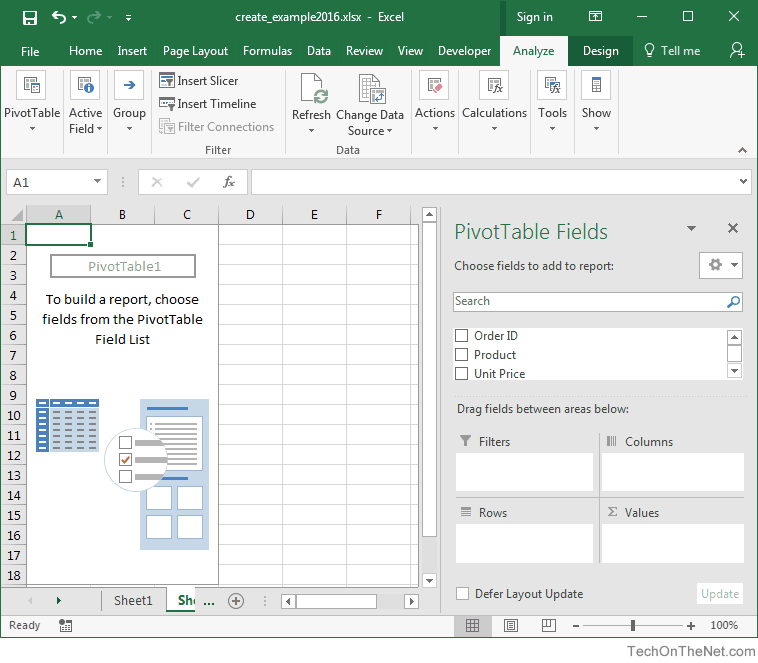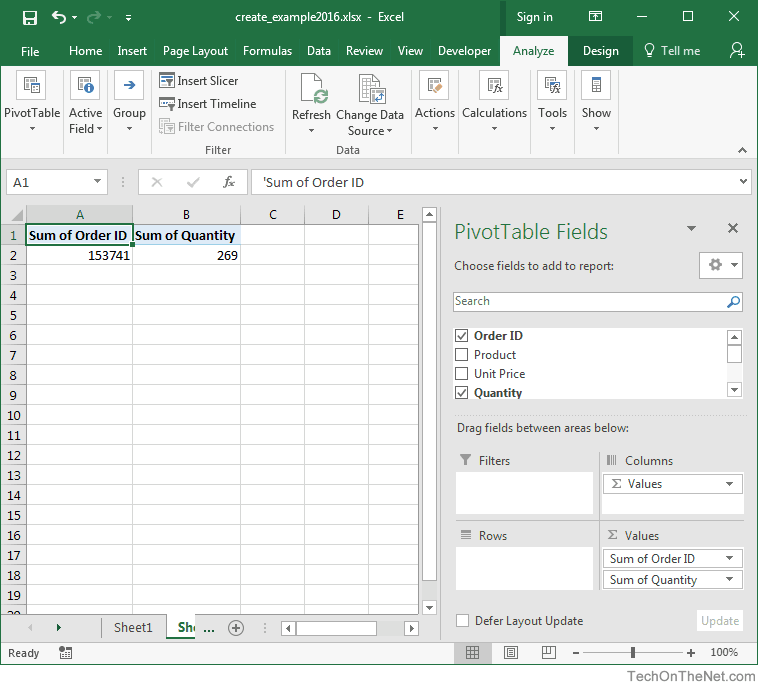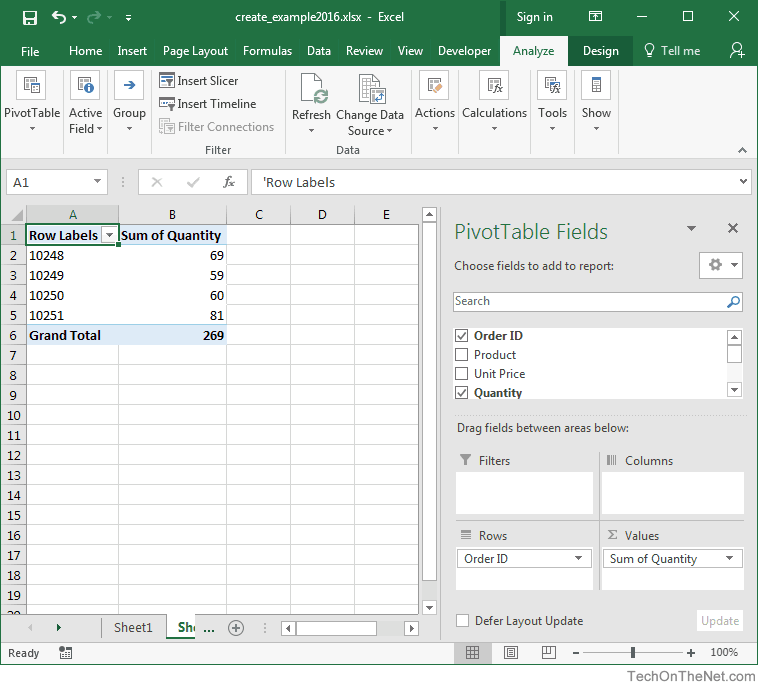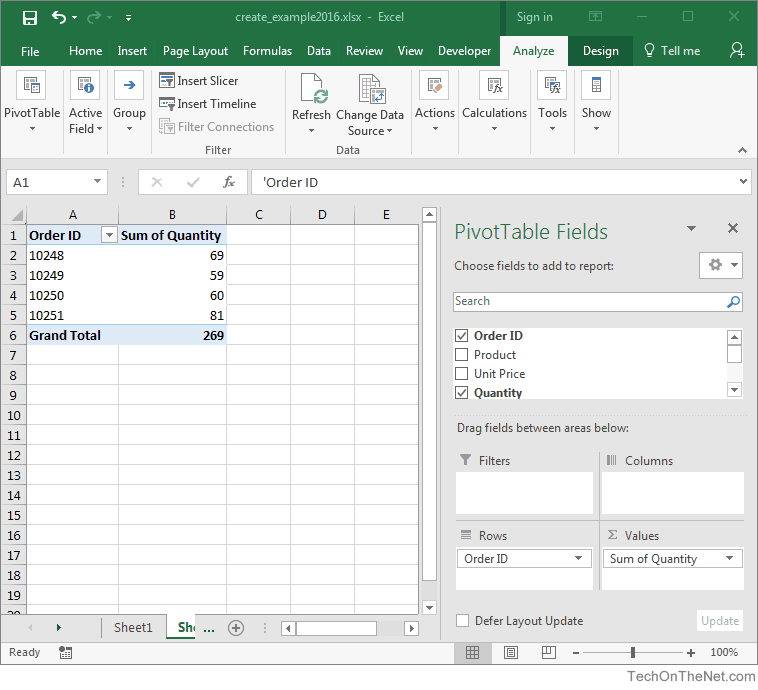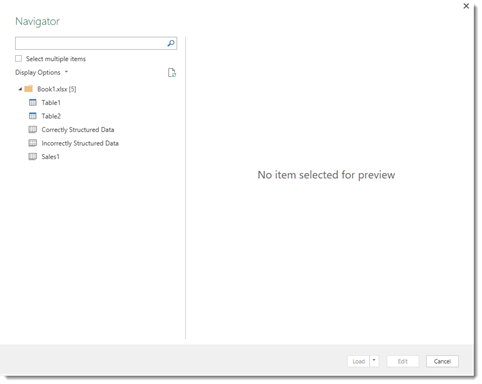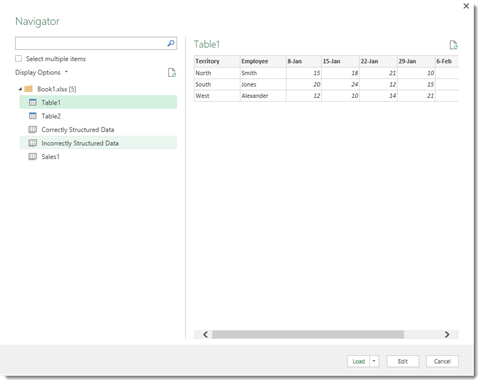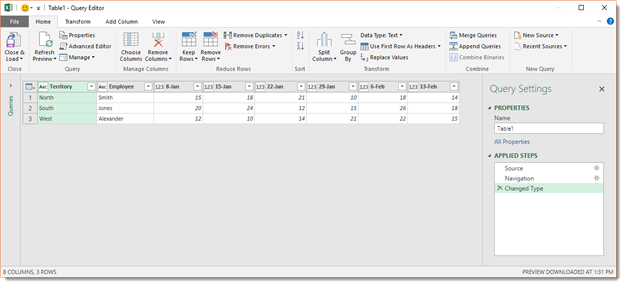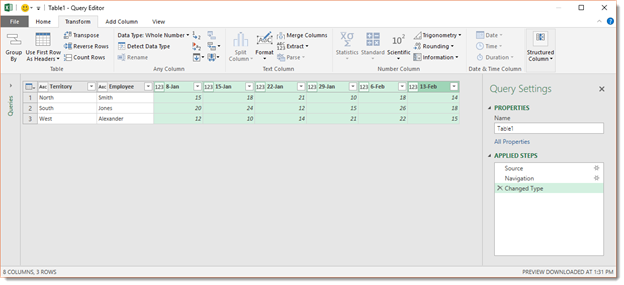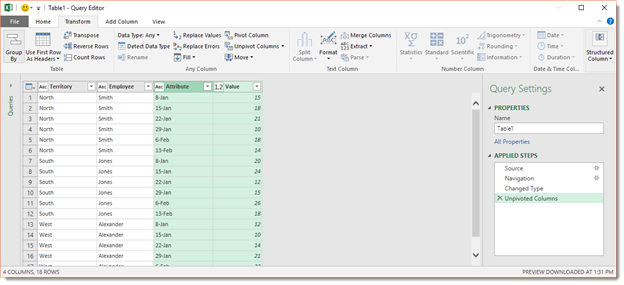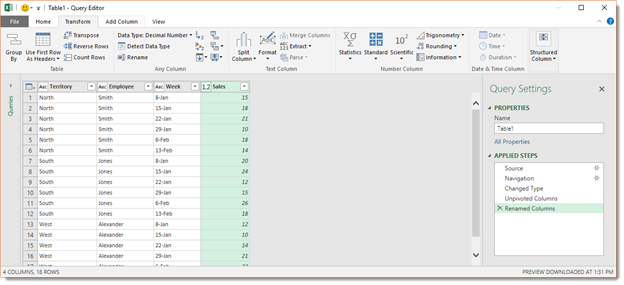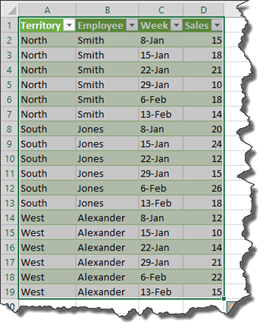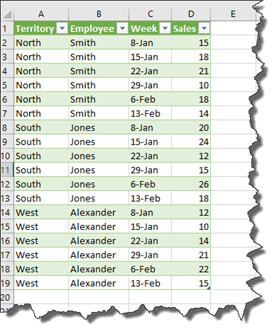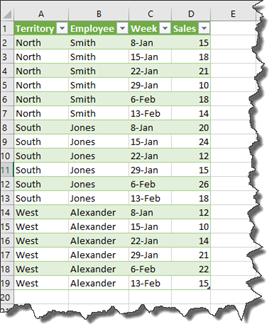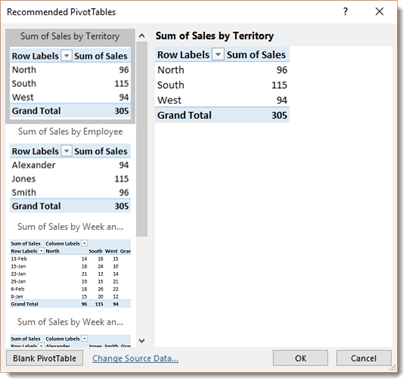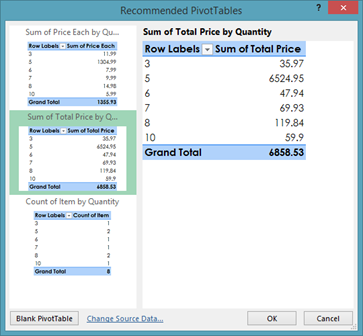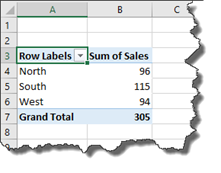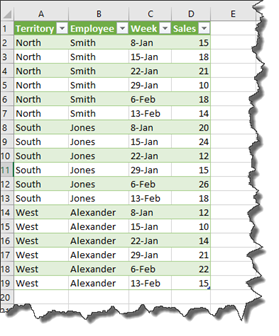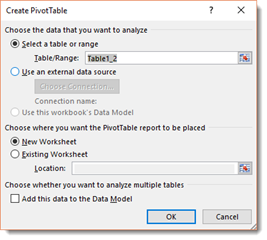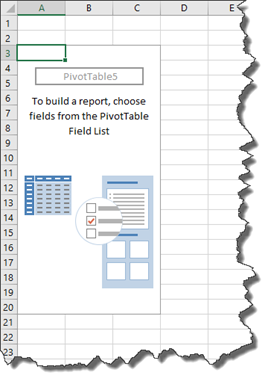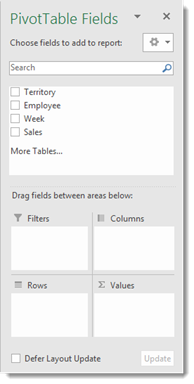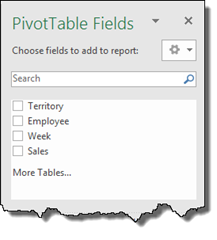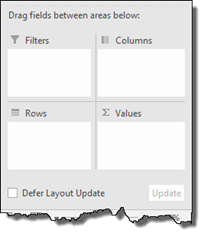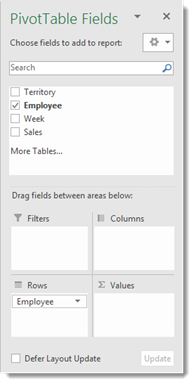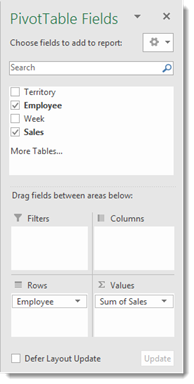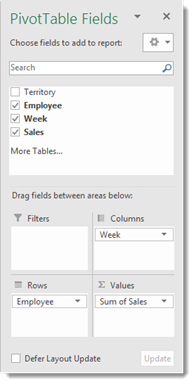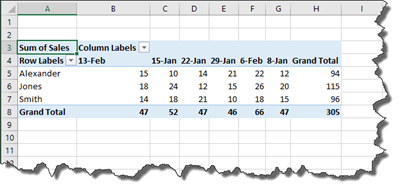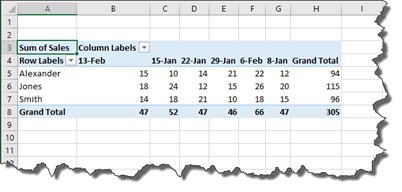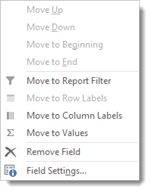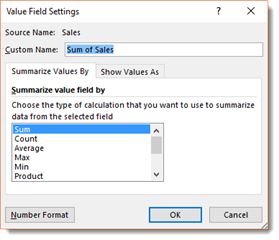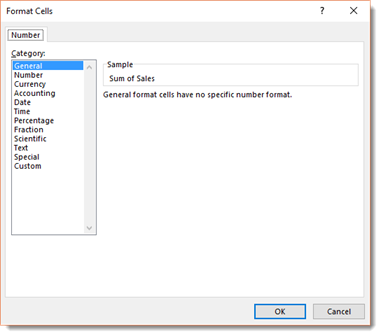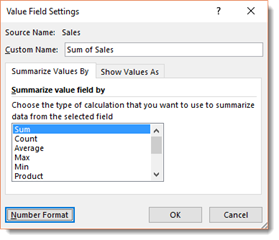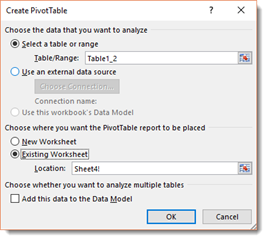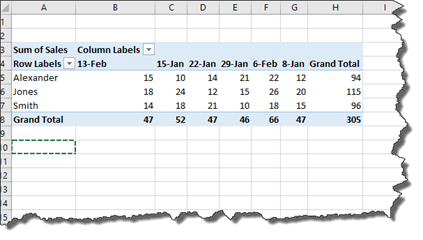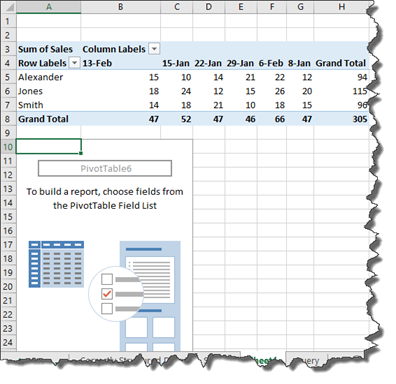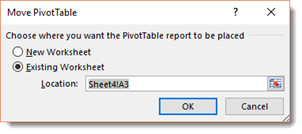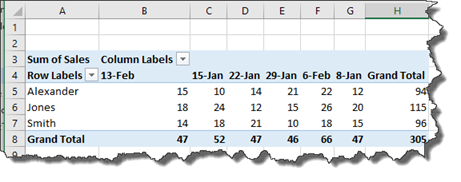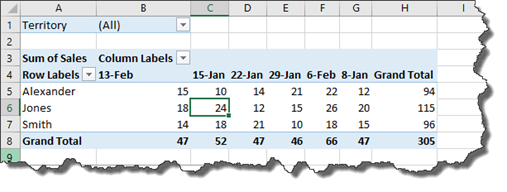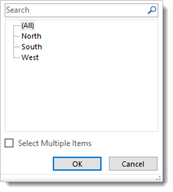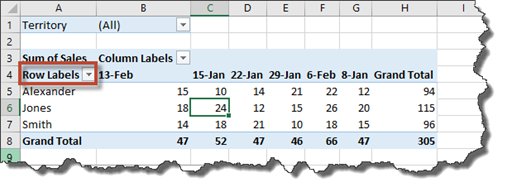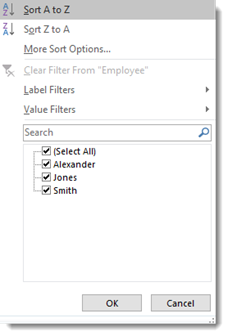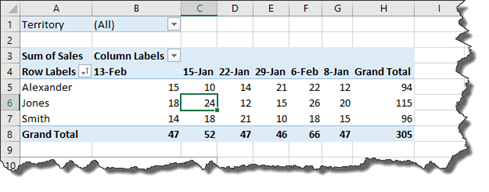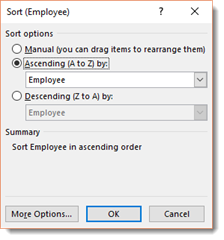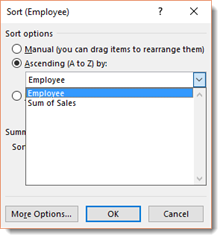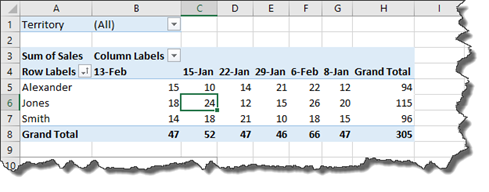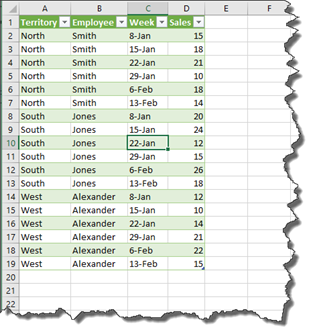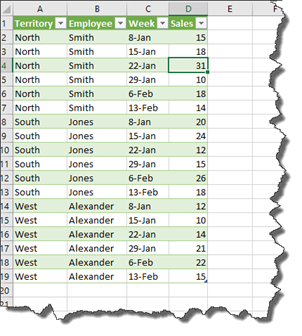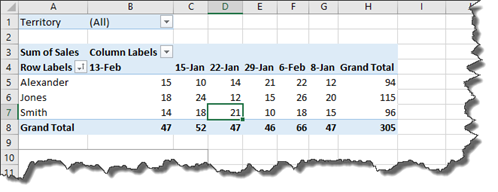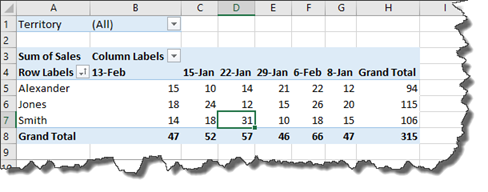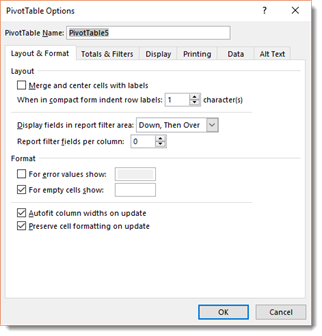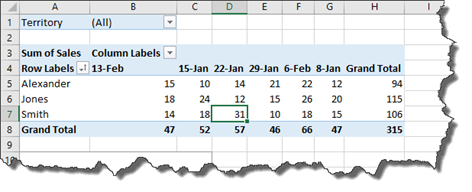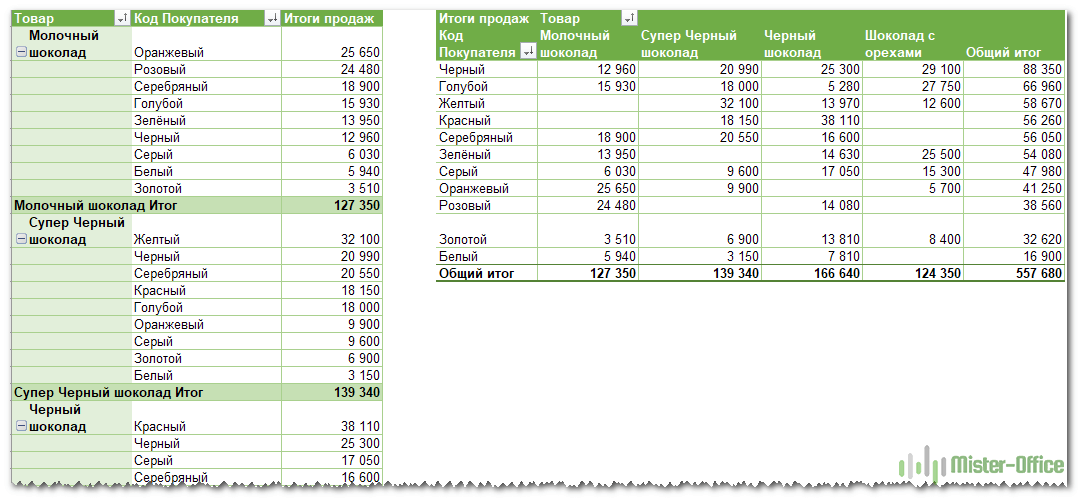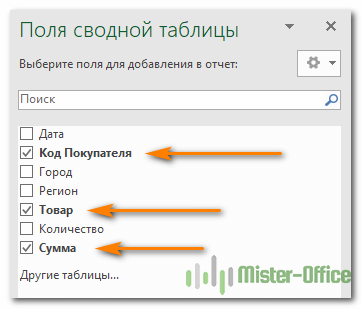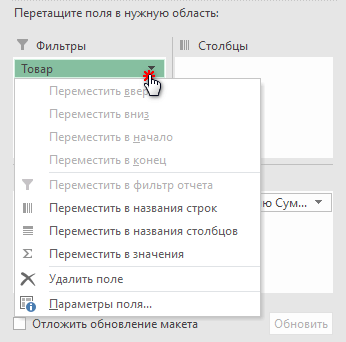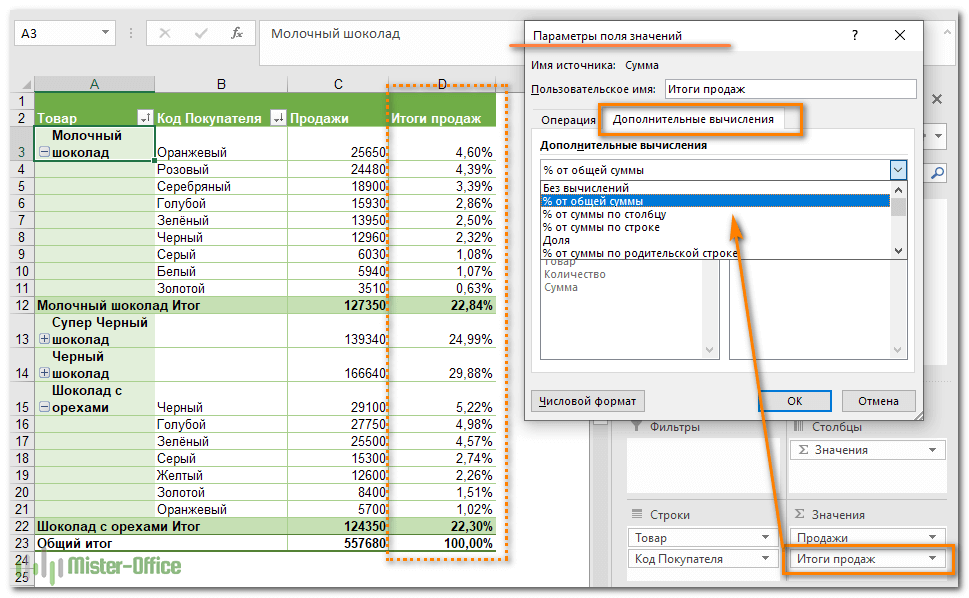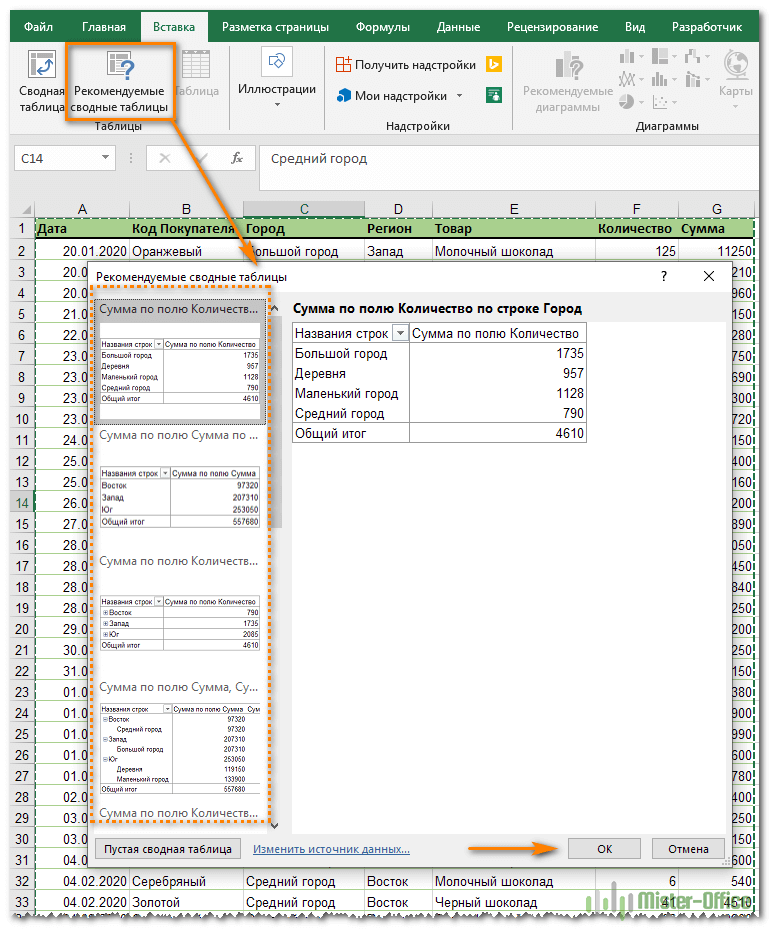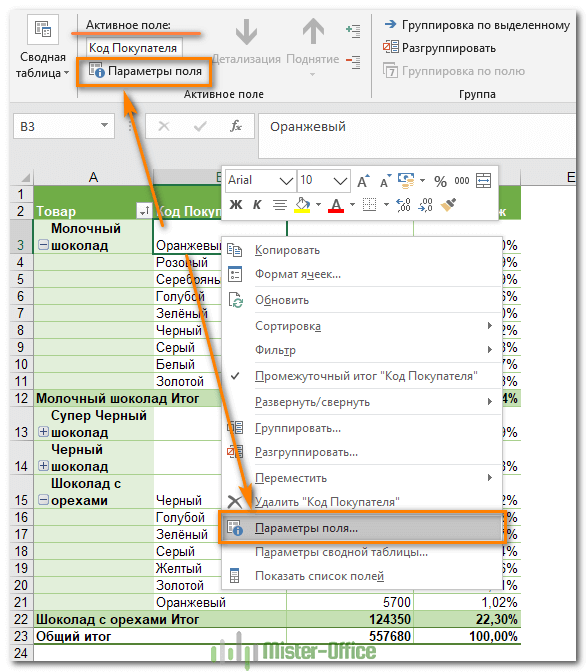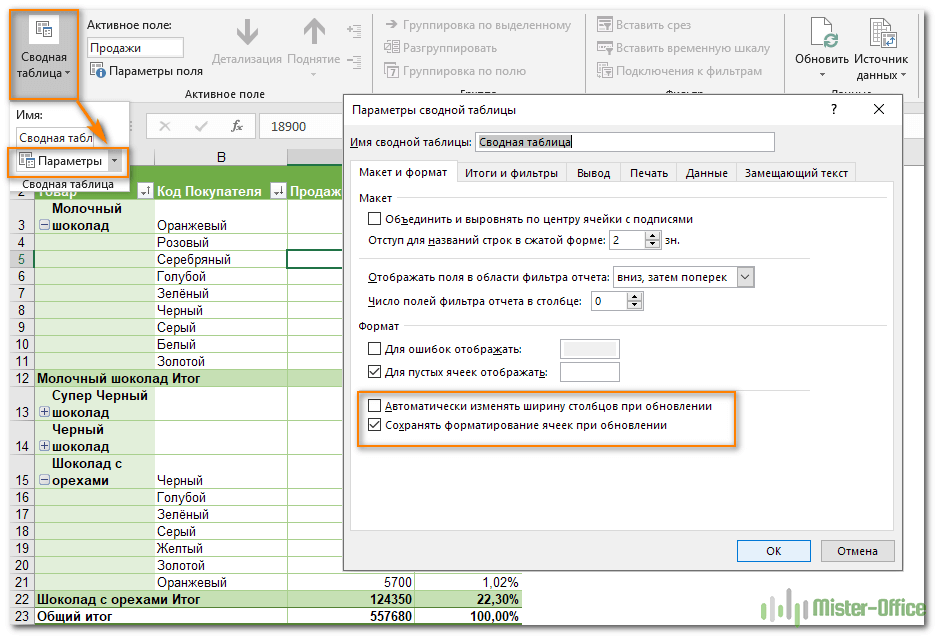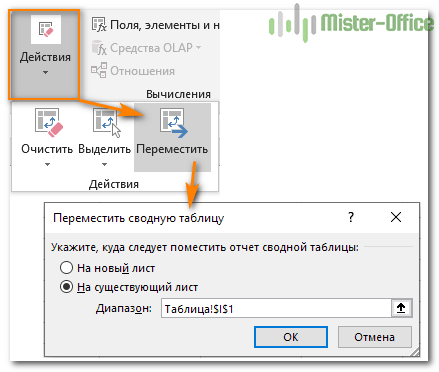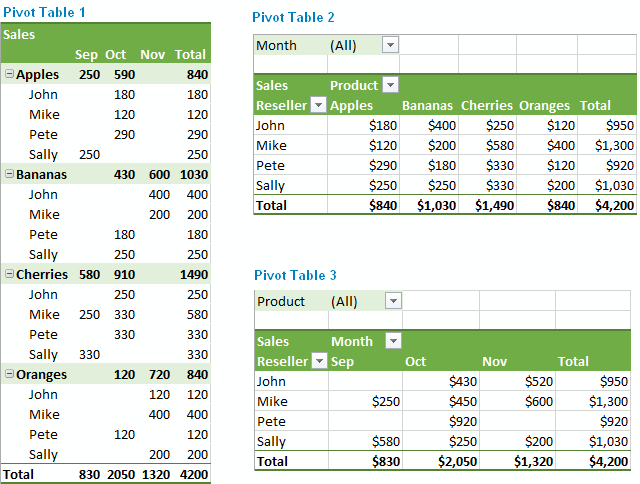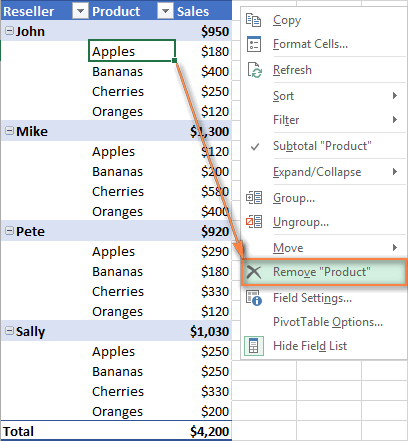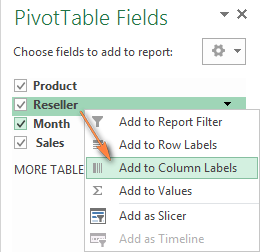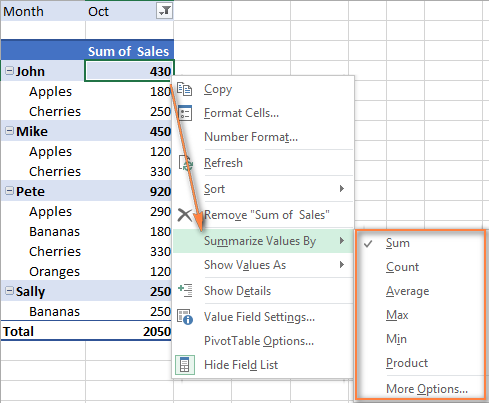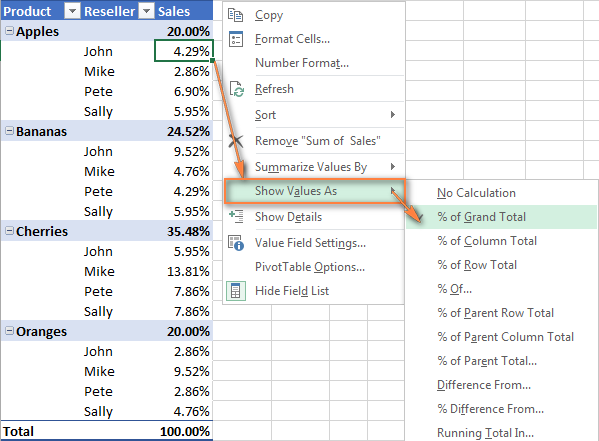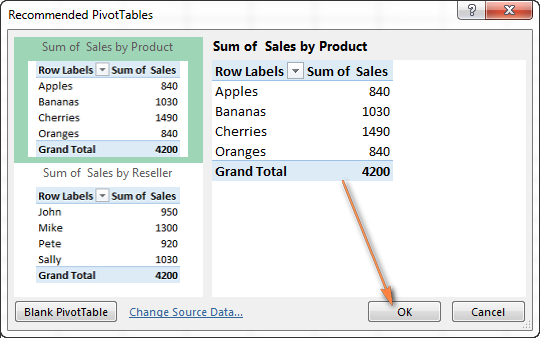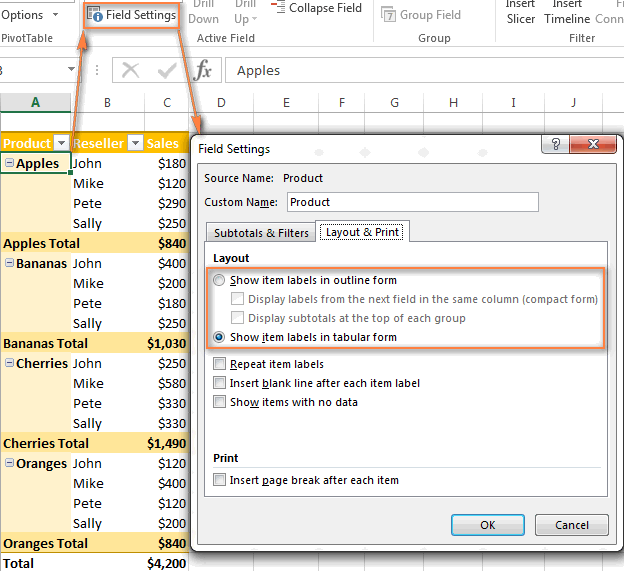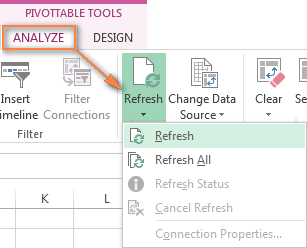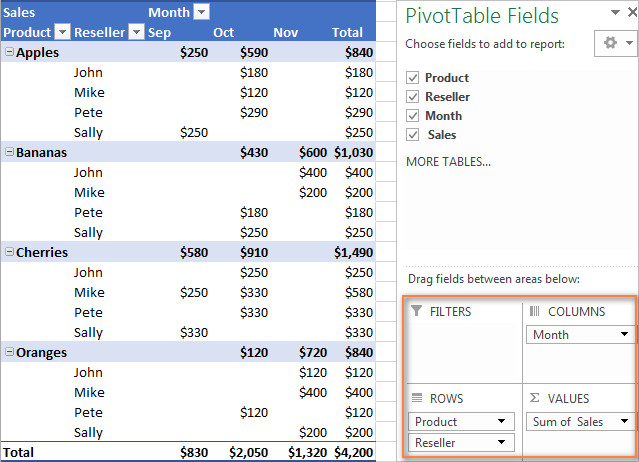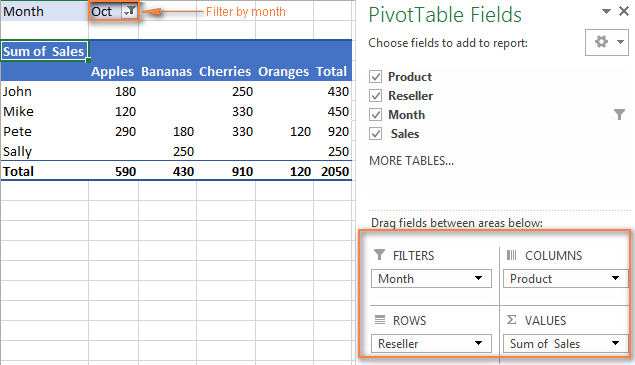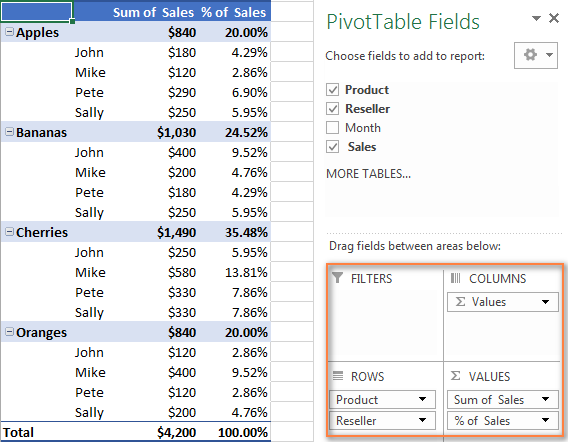Excel for Microsoft 365 Excel for Microsoft 365 for Mac Excel for the web Excel 2021 Excel 2019 Excel 2016 Excel 2013 Excel 2010 Excel 2007 More…Less
You can use a PivotTable to summarize, analyze, explore, and present summary data. PivotCharts complement PivotTables by adding visualizations to the summary data in a PivotTable, and allow you to easily see comparisons, patterns, and trends. Both PivotTables and PivotCharts enable you to make informed decisions about critical data in your enterprise. You can also connect to external data sources such as SQL Server tables, SQL Server Analysis Services cubes, Azure Marketplace, Office Data Connection (.odc) files, XML files, Access databases, and text files to create PivotTables, or use existing PivotTables to create new tables.
A PivotTable is an interactive way to quickly summarize large amounts of data. You can use a PivotTable to analyze numerical data in detail, and answer unanticipated questions about your data. A PivotTable is especially designed for:
-
Querying large amounts of data in many user-friendly ways.
-
Subtotaling and aggregating numeric data, summarizing data by categories and subcategories, and creating custom calculations and formulas.
-
Expanding and collapsing levels of data to focus your results, and drilling down to details from the summary data for areas of interest to you.
-
Moving rows to columns or columns to rows (or «pivoting») to see different summaries of the source data.
-
Filtering, sorting, grouping, and conditionally formatting the most useful and interesting subset of data enabling you to focus on just the information you want.
-
Presenting concise, attractive, and annotated online or printed reports.
For example, here’s a simple list of household expenses on the left, and a PivotTable based on the list to the right:
|
Sales data |
Corresponding PivotTable |
|
|
|
For more information, see Create a PivotTable to analyze worksheet data.
After you create a PivotTable by selecting its data source, arranging fields in the PivotTable Field List, and choosing an initial layout, you can perform the following tasks as you work with a PivotTable:
Explore the data by doing the following:
-
Expand and collapse data, and show the underlying details that pertain to the values.
-
Sort, filter, and group fields and items.
-
Change summary functions, and add custom calculations and formulas.
Change the form layout and field arrangement by doing the following:
-
Change the PivotTable form: Compact, Outline, or Tabular.
-
Add, rearrange, and remove fields.
-
Change the order of fields or items.
Change the layout of columns, rows, and subtotals by doing the following:
-
Turn column and row field headers on or off, or display or hide blank lines.
-
Display subtotals above or below their rows.
-
Adjust column widths on refresh.
-
Move a column field to the row area or a row field to the column area.
-
Merge or unmerge cells for outer row and column items.
Change the display of blanks and errors by doing the following:
-
Change how errors and empty cells are displayed.
-
Change how items and labels without data are shown.
-
Display or hide blank rows
Change the format by doing the following:
-
Manually and conditionally format cells and ranges.
-
Change the overall PivotTable format style.
-
Change the number format for fields.
-
Include OLAP Server formatting.
For more information, see Design the layout and format of a PivotTable.
PivotCharts provide graphical representations of the data in their associated PivotTables. PivotCharts are also interactive. When you create a PivotChart, the PivotChart Filter Pane appears. You can use this filter pane to sort and filter the PivotChart’s underlying data. Changes that you make to the layout and data in an associated PivotTable are immediately reflected in the layout and data in the PivotChart and vice versa.
PivotCharts display data series, categories, data markers, and axes just as standard charts do. You can also change the chart type and other options such as the titles, the legend placement, the data labels, the chart location, and so on.
Here’s a PivotChart based on the PivotTable example above.
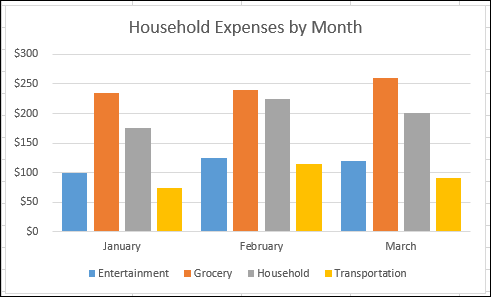
For more information, see Create a PivotChart.
If you are familiar with standard charts, you will find that most operations are the same in PivotCharts. However, there are some differences:
Row/Column orientation Unlike a standard chart, you cannot switch the row/column orientation of a PivotChart by using the Select Data Source dialog box. Instead, you can pivot the Row and Column labels of the associated PivotTable to achieve the same effect.
Chart types You can change a PivotChart to any chart type except an xy (scatter), stock, or bubble chart.
Source data Standard charts are linked directly to worksheet cells, while PivotCharts are based on their associated PivotTable’s data source. Unlike a standard chart, you cannot change the chart data range in a PivotChart’s Select Data Source dialog box.
Formatting Most formatting—including chart elements that you add, layout, and style—is preserved when you refresh a PivotChart. However, trendlines, data labels, error bars, and other changes to data sets are not preserved. Standard charts do not lose this formatting once it is applied.
Although you cannot directly resize the data labels in a PivotChart, you can increase the text font size to effectively resize the labels.
You can use data from a Excel worksheet as the basis for a PivotTable or PivotChart. The data should be in list format, with column labels in the first row, which Excel will use for Field Names. Each cell in subsequent rows should contain data appropriate to its column heading, and you shouldn’t mix data types in the same column. For instance, you shouldn’t mix currency values and dates in the same column. Additionally, there shouldn’t be any blank rows or columns within the data range.
Excel tables Excel tables are already in list format and are good candidates for PivotTable source data. When you refresh the PivotTable, new and updated data from the Excel table is automatically included in the refresh operation.
Using a dynamic named range To make a PivotTable easier to update, you can create a dynamic named range, and use that name as the PivotTable’s data source. If the named range expands to include more data, refreshing the PivotTable will include the new data.
Including totals Excel automatically creates subtotals and grand totals in a PivotTable. If the source data contains automatic subtotals and grand totals that you created by using the Subtotals command in the Outline group on the Data tab, use that same command to remove the subtotals and grand totals before you create the PivotTable.
You can retrieve data from an external data source such as a database, an Online Analytical Processing (OLAP) cube, or a text file. For example, you might maintain a database of sales records you want to summarize and analyze.
Office Data Connection files If you use an Office Data Connection (ODC) file (.odc) to retrieve external data for a PivotTable, you can input the data directly into a PivotTable. We recommend that you retrieve external data for your reports by using ODC files.
OLAP source data When you retrieve source data from an OLAP database or a cube file, the data is returned to Excel only as a PivotTable or a PivotTable that has been converted to worksheet functions. For more information, see Convert PivotTable cells to worksheet formulas.
Non-OLAP source data This is the underlying data for a PivotTable or a PivotChart that comes from a source other than an OLAP database. For example, data from relational databases or text files.
For more information, see Create a PivotTable with an external data source.
The PivotTable cache Each time that you create a new PivotTable or PivotChart, Excel stores a copy of the data for the report in memory, and saves this storage area as part of the workbook file — this is called the PivotTable cache. Each new PivotTable requires additional memory and disk space. However, when you use an existing PivotTable as the source for a new one in the same workbook, both share the same cache. Because you reuse the cache, the workbook size is reduced and less data is kept in memory.
Location requirements To use one PivotTable as the source for another, both must be in the same workbook. If the source PivotTable is in a different workbook, copy the source to the workbook location where you want the new one to appear. PivotTables and PivotCharts in different workbooks are separate, each with its own copy of the data in memory and in the workbooks.
Changes affect both PivotTables When you refresh the data in the new PivotTable, Excel also updates the data in the source PivotTable, and vice versa. When you group or ungroup items, or create calculated fields or calculated items in one, both are affected. If you need to have a PivotTable that’s independent of another one, then you can create a new one based on the original data source, instead of copying the original PivotTable. Just be mindful of the potential memory implications of doing this too often.
PivotCharts You can base a new PivotTable or PivotChart on another PivotTable, but you cannot base a new PivotChart directly on another PivotChart. Changes to a PivotChart affect the associated PivotTable, and vice versa.
Changes in the source data can result in different data being available for analysis. For example, you may want to conveniently switch from a test database to a production database. You can update a PivotTable or a PivotChart with new data that is similar to the original data connection information by redefining the source data. If the data is substantially different with many new or additional fields, it may be easier to create a new PivotTable or PivotChart.
Displaying new data brought in by refresh Refreshing a PivotTable can also change the data that is available for display. For PivotTables based on worksheet data, Excel retrieves new fields within the source range or named range that you specified. For reports based on external data, Excel retrieves new data that meets the criteria for the underlying query or data that becomes available in an OLAP cube. You can view any new fields in the Field List and add the fields to the report.
Changing OLAP cubes that you create Reports based on OLAP data always have access to all of the data in the cube. If you created an offline cube that contains a subset of the data in a server cube, you can use the Offline OLAP command to modify your cube file so that it contains different data from the server.
See Also
Create a PivotTable to analyze worksheet data
Create a PivotChart
PivotTable options
Use PivotTables and other business intelligence tools to analyze your data
Need more help?
Want more options?
Explore subscription benefits, browse training courses, learn how to secure your device, and more.
Communities help you ask and answer questions, give feedback, and hear from experts with rich knowledge.
This Excel tutorial explains how to create a pivot table in Excel 2016 (with screenshots and step-by-step instructions).
What is a Pivot Table?
A pivot table is a tool that allows you to quickly summarize and analyze data in your spreadsheet.
You can use a pivot table when:
- You want to arrange and summarize your data.
- The data in your spreadsheet is too large and complex to analyze in its original format.
Subscribe
If you want to follow along with this tutorial, download the example spreadsheet.
Download Example
Steps to Create a Pivot Table
To create a pivot table in Excel 2016, you will need to do the following steps:
-
Before we get started, we first want to show you the data for the pivot table. In this example, the data is found on Sheet1.
-
Highlight the cell where you’d like to create the pivot table. In this example, we’ve selected cell A1 on Sheet2.
-
Next, select the Insert tab from the toolbar at the top of the screen. In the Tables group, click on the Tables button and select PivotTable from the popup menu.
-
A Create PivotTable window should appear. Select the range of data for the pivot table and click on the OK button. In this example, we’ve chosen cells A1 to F16 in Sheet1 as indicated by
Sheet1!$A$1:$F$16.Your pivot table should now appear as follows:
-
Next, choose the fields to add to the report. In this example, we’ve selected the checkboxes next to the Order ID and Quantity fields.
-
Next in the Values section, click on the «Sum of Order ID» and drag it to the Rows section.
-
Finally, we want the title in cell A1 to show as «Order ID» instead of «Row Labels». To do this, select cell A1 and type Order ID.
Your pivot table should now display the total quantity for each Order ID as follows:
Congratulations, you have finished creating your first pivot table in Excel 2016!
A pivot table is a tool that you can use to summarize data when you have a lot of it in a worksheet. A pivot table can count totals, give an average of the data, or sort data – in addition to other things. In this article, we are going to go in-depth as we learn to create and work with pivot tables.
Although pivot tables can be fairly easy to create, it is important to have the data in your worksheet structured properly before creating a pivot table. Before we learn to create pivot tables in this article, we are going to first learn the correct structure for source data used in a pivot table, as well as why it is important.
Here are the basic rules for structuring your data in preparation for a pivot table.
1. All data should be in a table. In other words, create a table for your data. Do not just have your data listed in a regular worksheet.
2. Your data should start in cell A1.
3. Your columns should all have header field names or titles.
4. The header titles should be unique.
5. You should not have blank cells, but you really should not have blank cells in Column A.
6. Take the time to remove any totals or subtotals in data rows. The pivot table will do the summarizing for you.
You should take the time to commit these rules to memory if you plan on using pivot tables frequently in Excel. These are basic rules, and ones that you will need to follow if you want to create effective pivot tables.
When you are preparing a data source for pivot tables, you should build your data downward. In other words, you want to keep your important data to rows. It is almost instinct – if it can be instinct in Excel – to use columns to organize our data. For example, if we are listing weekly sales, we create a column for each week. This is actual, useful data! We use rows for products, territories, or sales people. It is a backward way of doing things, and it limits the use of pivot tables as well. Instead, columns should be used to define the type of data. The actual data should be placed in rows so that we can better produce different slices of the data.
Take a look at the table below.
Notice that we have useful data in the columns. The useful data is the weeks in which sales occurred.
Now let’s try to create a pivot table from this data.
In the snapshot above, you can see the PivotTable Fields pane on the right. Notice how all the dates are listed.
To the right is our pivot table.
Note in the pivot table that there are columns that are labeled «Sum of…». The week date follows. We were unable to get a sum of the sales for each week because the useful data was listed in a column instead of a row.
Now let’s redo our table.
Take a look at how the new table is structured.
The different header fields are shown as columns.
The data records are shown in rows.
Let’s repeat that again. Consider these two more rules for pivot tables.
1. The different header fields are shown as columns.
2. The data records are shown in rows.
Our new table contains the same data as the old table. The difference is that it is organized in a way that a pivot table will be an effective way to summarize and analyze the data.
Here is another way to remember how to structure data properly before creating a pivot table.
All values of the same type should be in the same column. This means if you have dates in your table, the dates should all be in one column. If you have people’s names, those names should all be in a column.
Let’s create a pivot table from the new source data.
You can see that now the pivot table was able to summarize our data for us.
In the last section of this article, we looked at a table in which the data was incorrectly structured for a pivot table. The table looked like this:
We then redid the table in another worksheet so that the data was structured correctly. That table looked like this:
We did not have a lot of data to restructure. In fact, since we were only showing you an example, we did not even put all of the data into our new table. We felt like the data we showed you in the new table was enough to show you how it should be structured.
However, creating an entirely new table will not always be possible for you. You may need to restructure the data for a pivot table, but there may be so much data that it will not be humanly possible to just create a new table for it.
In Excel 2013, there was an add-in called Power Query. Once you installed it, you could use it to unpivot data and structure it correctly. Power Query is no longer an add-in for Excel 2016. It is now just known as a query, and it comes as part of Excel.
Let’s look at our table with the incorrectly structured data again.
We need the dates that appear in columns to appear in rows instead.
To do this, go to the Data tab, then click the New Query dropdown arrow.
We are going to use our worksheet in our workbook, so we will select «From File».
As we just stated, we are going to use a worksheet in our workbook, so we are going to choose «From Workbook» from the menu pictured above.
Choose the workbook that contains the data you need to restructure, then click the Import button.
We are going to select Book1.
The Navigator window will then open.
Choose either the table or worksheet that contains the data you want to restructure.
We have selected the table that contains our data.
Click the Edit button.
You will then see the Query Editor.
Click the Transform tab in the Query Editor’s Ribbon.
It looks like this:
Select the columns that you need to unpivot. These are the columns with useful data that should have been put into rows.
We have selected ours below.
Next, go to the Any Column group under the Transform tab. Click the Unpivot Columns downward arrow, and select Unpivot Columns.
Excel now restructures the data for you, as you can see below.
Let’s rename the two new columns.
Now all we need to do is output the table to a new worksheet.
To do this, go to the File tab. Select Close & Load.
The query is loaded onto a new worksheet in your workbook.
Using Recommended Pivot Tables
Recommended Pivot Tables is a feature that was new to Excel 2013. With Recommended Pivot Tables, Excel analyzes the data that you have in your spreadsheet, then suggests possible pivot tables for you to use.
Take a look at our worksheet below:
This worksheet is simply a list of sales, the employees who made the sales, and the weeks in which the sales were made. It also shows the territory for each employee.
To see the recommended pivot tables, click anywhere in the worksheet.
Go to the Insert tab, then click Recommended Pivot Tables in the Tables group.
You will then see the Recommended PivotTables dialogue box.
In the dialogue box, you will see Excel’s recommended PivotTables.
As you can see, in our recommended pivot tables, Excel summarizes the data by the price of each item, the total price, and the number of items.
If you want to use one of these suggested pivot tables, simply click on the pivot tables in the column on the left.
We have chosen the total price for each item.
That pivot table is now visible in the right column.
Click the OK button.
The pivot table is then placed into a new sheet, as shown below.
Creating a PivotTable from Scratch
In the last section of this article, we learned how Excel can create pivot tables for us. Now let’s learn how to create a pivot table on our own from scratch.
We are going to use the same worksheet that we used when working with Recommended PivotTables. It is pictured below.
In starting to create your own pivot table, you do not need to select or highlight data. The only way that you would be required to select data is if you had a blank column or row within your data. Of course, you would not want that included in your pivot table, so you would select the data you did want included.
To start creating your pivot table, click within the data, then go to the Insert tab. Click the PivotTable button.
You will then see the Create PivotTable dialogue box.
In the Select a Table or Range field, Excel fills in the range of cells that contains your data.
You can compare the range of cells listed above with our worksheet, and you can see that all the data was included. Unless you need to change the range of cells, you do not need to enter anything into this field.
Next, decide if you want the new pivot table to appear in the existing worksheet (with your data) or in a new worksheet. It is recommended that you place it into a different worksheet, but the choice is ultimately yours. If you place it in the existing worksheet, you will need to specify the location where you want to place it.
Click OK.
This is what you will see in a new worksheet:
This is where your pivot table will start.
If you look to the far right side of the Excel window, you will see PivotTable Fields, as shown below.
You will use this to create your pivot table.
In the top section, you will see your columns listed.
The bottom section contains the sections of your pivot table.
-
Filters is the filter above the pivot table.
-
Columns are the column headings.
-
Rows are row headings.
-
Values are the crossover of the rows and columns.
The only thing in the bottom section that you need to make a pivot table work is Values. You will find that Rows, Columns, and Filters help to organize the data and information in the pivot table.
To see what we mean, let’s choose a column from the top half.
We are going to choose Employee. We want each employee to appear in a row, so we drag it to the Rows section in the bottom half.
Next, we are going to click on Sales in the top half, and drag it to the Values section.
We chose Sum of Sales.
We are going to drag Week to the Columns section.
Now, if we look at our pivot table, we see that Excel has summarized the number of sales in our worksheet.
With pivot tables, there is something you need to keep in mind. If you drop a text field into values, Excel will assume you want to count the values. We did this, and it counted the number of occurrences of the item in our data. If you drop a numerical field into Values, Excel will assume you want a sum of the items.
If you make a mistake and drag something into Values, Columns, Filters, or Rows that you do not want there, you can simply click and drag it back to the top section. This will remove it.
You can also drag and drop to and from Values, Columns, Rows, and Filters.
You can do these things to create the pivot table that you want.
Changing the Formatting and Formulas of PivotTables
It is easy to create a pivot table in Excel 2016, but that is just where the fun begins. Now that you created a pivot table, it is time to learn how to format it.
Below is our pivot table.
If you wanted to format the data in the pivot table, you could do so by selecting a column or row, then going to the Home tab and applying formatting, such as changing the font type, font size, or font color. Those are very basic Excel skills and easy enough for you to do.
However, if you applied formatting in this manner, if you ever refreshed the data in your pivot table or added rows or columns, the formatting might not be applied.
Instead, go to the panel on the right side of the Excel window where we created the pivot table. In the bottom section of the pivot table, click the downward arrow to the right of the field you want to format.
In the snapshot below, we are going to click the downward arrow to the right of the Employee field.
Click on Field Settings, as shown above, to format the field.
However, in order to show you a better example, we are going to click on the field Sum of Sales in the Values section, then choose Field Settings from the menu.
We then see the Value Field Settings dialogue box.
In this dialogue box, we can change the name of the field in the pivot table by going to the Custom Name field.
Right now, we have the cells in this field formatted so that all numbers display as currency. If we wanted to change that, we would click the Number Format button.
Choose the formatting for our cells, then click OK.
This will return you to the Value Field Settings dialogue box.
Also in the Value Field Settings dialogue box, we can change the function. Right now, we have it at the default, which is Sum. It can be changed to Count, Average, Max, Min, etc. All of these functions relate to the total sales. For example, average of total sales, and so on.
Click OK when you are finished.
You can also add the same field more than once.
This means that, if you wanted, you could change the function for the Sales field to Count. Then, you could drag the Sales field to the Values section again, which would display the Sum of Sales.
Just make sure you change the number format that matches the function. We would not want Currency for Sales function, for example.
Creating Different PivotTables Using the Same Data
You can create as many pivot tables as you need to using the same data from the same worksheet. You can choose to place the pivot tables together, or you can place them in different worksheets.
We are going to create another pivot table by clicking in the data, then going to the Insert tab, then click on the PivotTable button.
As you can see in the dialogue box pictured above, we have chosen to place the new pivot table in the same worksheet as the pivot table that we created earlier in this article. We did this by choosing Existing Worksheet, then clicking on the tab of the worksheet that contained the pivot table. Next, we clicked on the cell where we want the upper left hand corner of the pivot table to be placed.
Click the OK button in the Create PivotTable dialogue box.
You can now see our new pivot table below our existing pivot table.
We can now add columns, rows, and values to our new pivot table by following the steps we learned earlier in this article.
Moving PivotTables
You can move a pivot table to a new location within a worksheet or to a new worksheet entirely.
To move a pivot table, click within the data of the pivot table, then click the Analyze tab under PivotTable Tools in the Ribbon, as pictured below.
Next, click Move PivotTable in the Actions group.
You will then see the Move PivotTable dialogue box.
You can choose to move the pivot table to a new worksheet, or you can click on a cell in the existing worksheet where you want to place the pivot table.
Click the OK button when you are finished.
The pivot table is moved for you.
Deleting PivotTables
To delete a pivot table, click within the data, then go to the Analyze tab under PivotTable Tools in the Ribbon.
Click the Select button, then choose Entire PivotTable.
This selects the PivotTable.
You can then press Delete on your keyboard.
The Report Filter Option
In the snapshot below, we have a simple pivot table.
You can see that we have dragged and dropped the Employee field into the Rows section, and the Sales field into the Values section in order to create the pivot table.
Now we are going to learn what happens when you drag a field to the Filters section.
For this example, we are going to drag the Territory field to the Filters section.
When we do this, we can see the filter is added above our pivot table.
If we click the downward arrow to the right of Territory, we see our filtering options:
We can now filter the data in our pivot table by the territory of the employee.
Of course, we can also add another filter to our pivot table to further refine the data that is summarized
Sorting Data in a PivotTable
Data in a pivot table can be sorted by row or column labels, as well as values.
Whenever you create a pivot table, Excel does the sorting for you. Excel puts row and column labels in the order that they appeared in the original data worksheet.
If you want to sort row or column labels, simply click the dropdown arrow that appears to the right of either Row Labels or Column labels.
You can see Row Labels circled in red below.
We are going to click the downward arrow.
As you can see in the next snapshot, we are now given the ability to sort the labels alphabetically from A to Z, or Z to A.
We are going to click on Sort A to Z.
Now, if you want to sort values in a pivot table, click the downward arrow again.
This time, click on More Sort Options.
You will then see the following dialogue box.
Choose if you want to sort the values from A to Z or Z to A by putting a check beside your choice.
Next, click the downward arrow in the field below your choice, as shown below.
In the snapshot above, you see that we can also sort by Sum of Sales – or our values.
Select the option, then click OK.
Our data is then sorted by values.
Refreshing the Data in a PivotTable
A pivot table is based on data that is contained in a worksheet. If you change the data in the worksheet after you have created a pivot table, you will need to refresh the data in the pivot table so that it reflects the current data in the original worksheet.
Let’s show you what we mean so that it makes sense.
Below is our pivot table.
Now, we are going to go back to our original worksheet.
Let’s say, as an example, that there has been a sales increase for the employee named Smith. It is currently showing that he made 21 sales on the week of January 27th, but we are now going to make it show that he actually had 31 sales. To change that data, all we have to do is click in the cell, then make the change.
However, when we go back to our pivot table, our Sum of Sales column still reflects the 21 sales we originally said we made.
We need to refresh the data so the changes made in the original data are reflected in our pivot table.
To do this, go to the Analyze tab under PivotTable Tools. Go to the Refresh dropdown menu, and select Refresh All.
As you can see, the data in our pivot table is now refreshed.
Another thing you can do to make sure that your data stays refreshed is to set your options in Excel so that the data in your pivot table is refreshed each time you open the workbook.
To do this, go to the Analyze tab again.
Click the Options button in the PivotTable group.
You will then see this dialogue box:
Click the Data tab.
Put a checkmark beside Refresh Data When Opening the File, then click OK.
Verifying the Data in a PivotTable
It is easy to take for granted that the data presented in a pivot table is correct.
However, if you ever wanted to double check to make sure that the data is correct, there is an easy way to do that.
Let’s say we want to verify that the employee named Smith really made 31 sales.
To do this, double click on the cell that contains the value that you want to double check. In this case, it is the cell we have selected above.
When you double click on the cell, Excel pulls up all the data that it used to come up with this number.
In our case, it is the row entry for Smith and his territory. However, if the value you clicked on used multiple bits of data, it would list all the data that it used to produce the value.
The data shown above is displayed in a new worksheet. You can choose whether you want to keep the worksheet or delete it.
Skip to content
В этом руководстве вы узнаете, что такое сводная таблица, и найдете подробную инструкцию, как по шагам создавать и использовать её в Excel.
Если вы работаете с большими наборами данных в Excel, то сводная таблица очень удобна для быстрого создания интерактивного представления из множества записей. Помимо прочего, она может автоматически сортировать и фильтровать информацию, подсчитывать итоги, вычислять среднее значение, а также создавать перекрестные таблицы. Это позволяет взглянуть на ваши цифры совершенно с новой стороны.
Важно также и то, что при этом ваши исходные данные не затрагиваются – что бы вы не делали с вашей сводной таблицей. Вы просто выбираете такой способ отображения, который позволит вам увидеть новые закономерности и связи. Ваши показатели будут разделены на группы, а огромный объем информации будет представлен в понятной и доступной для анализа форме.
- Что такое сводная таблица?
- Как создать сводную таблицу.
- 1. Организуйте свои исходные данные
- 2. Создаем и размещаем макет
- 3. Как добавить поле
- 4. Как удалить поле из сводной таблицы?
- 5. Как упорядочить поля?
- 6. Выберите функцию для значений (необязательно)
- 7. Используем различные вычисления в полях значения (необязательно)
- Работа со списком показателей сводной таблицы
- Закрытие и открытие панели редактирования.
- Воспользуйтесь рекомендациями программы.
- Давайте улучшим результат.
- Как обновить сводную таблицу.
- Как переместить на новое место?
- Как удалить сводную таблицу?
Что такое сводная таблица?
Это инструмент для изучения и обобщения больших объемов данных, анализа связанных итогов и представления отчетов. Они помогут вам:
- представить большие объемы данных в удобной для пользователя форме.
- группировать информацию по категориям и подкатегориям.
- фильтровать, сортировать и условно форматировать различные сведения, чтобы вы могли сосредоточиться на самом актуальном.
- поменять строки и столбцы местами.
- рассчитать различные виды итогов.
- разворачивать и сворачивать уровни данных, чтобы узнать подробности.
- представить в Интернете сжатые и привлекательные таблицы или печатные отчеты.
Например, у вас множество записей в электронной таблице с цифрами продаж шоколада:
И каждый день сюда добавляются все новые сведения. Одним из возможных способов суммирования этого длинного списка чисел по одному или нескольким условиям является использование формул, как было продемонстрировано в руководствах по функциям СУММЕСЛИ и СУММЕСЛИМН.
Однако, когда вы хотите сравнить несколько показателей по каждому продавцу либо по отдельным товарам, использование сводных таблиц является гораздо более эффективным способом. Ведь при использовании функций вам придется писать много формул с достаточно сложными условиями. А здесь всего за несколько щелчков мыши вы можете получить гибкую и легко настраиваемую форму, которая суммирует ваши цифры как вам необходимо.
Вот посмотрите сами.
Этот скриншот демонстрирует лишь несколько из множества возможных вариантов анализа продаж. И далее мы рассмотрим примеры построения сводных таблиц в Excel 2016, 2013, 2010 и 2007.
Как создать сводную таблицу.
Многие думают, что создание отчетов при помощи сводных таблиц для «чайников» является сложным и трудоемким процессом. Но это не так! Microsoft много лет совершенствовала эту технологию, и в современных версиях Эксель они очень удобны и невероятно быстры.
Фактически, вы можете сделать это всего за пару минут. Для вас – небольшой самоучитель в виде пошаговой инструкции:
1. Организуйте свои исходные данные
Перед созданием сводного отчета организуйте свои данные в строки и столбцы, а затем преобразуйте диапазон данных в таблицу. Для этого выделите все используемые ячейки, перейдите на вкладку меню «Главная» и нажмите «Форматировать как таблицу».
Использование «умной» таблицы в качестве исходных данных дает вам очень хорошее преимущество — ваш диапазон данных становится «динамическим». Это означает, что он будет автоматически расширяться или уменьшаться при добавлении или удалении записей. Поэтому вам не придется беспокоиться о том, что в свод не попала самая свежая информация.
Полезные советы:
- Добавьте уникальные, значимые заголовки в столбцы, они позже превратятся в имена полей.
- Убедитесь, что исходная таблица не содержит пустых строк или столбцов и промежуточных итогов.
- Чтобы упростить работу, вы можете присвоить исходной таблице уникальное имя, введя его в поле «Имя» в верхнем правом углу.
2. Создаем и размещаем макет
Выберите любую ячейку в исходных данных, а затем перейдите на вкладку Вставка > Сводная таблица .
Откроется окно «Создание ….. ». Убедитесь, что в поле Диапазон указан правильный источник данных. Затем выберите местоположение для свода:
- Выбор нового рабочего листа поместит его на новый лист, начиная с ячейки A1.
- Выбор существующего листа разместит в указанном вами месте на существующем листе. В поле «Диапазон» выберите первую ячейку (то есть, верхнюю левую), в которую вы хотите поместить свою таблицу.
Нажатие ОК создает пустой макет без цифр в целевом местоположении, который будет выглядеть примерно так:
Полезные советы:
- В большинстве случаев имеет смысл размещать на отдельном рабочем листе. Это особенно рекомендуется для начинающих.
- Ежели вы берете информацию из другой таблицы или рабочей книги, включите их имена, используя следующий синтаксис: [workbook_name]sheet_name!Range. Например, [Книга1.xlsx] Лист1!$A$1:$E$50. Конечно, вы можете не писать это все руками, а просто выбрать диапазон ячеек в другой книге с помощью мыши.
- Возможно, было бы полезно построить таблицу и диаграмму одновременно. Для этого в Excel 2016 и 2013 перейдите на вкладку «Вставка», щелкните стрелку под кнопкой «Сводная диаграмма», а затем нажмите «Диаграмма и таблица». В версиях 2010 и 2007 щелкните стрелку под сводной таблицей, а затем — Сводная диаграмма.
- Организация макета.
Область, в которой вы работаете с полями макета, называется списком полей. Он расположен в правой части рабочего листа и разделен на заголовок и основной раздел:
- Раздел «Поле» содержит названия показателей, которые вы можете добавить. Они соответствуют именам столбцов исходных данных.
- Раздел «Макет» содержит область «Фильтры», «Столбцы», «Строки» и «Значения». Здесь вы можете расположить в нужном порядке поля.
Изменения, которые вы вносите в этих разделах, немедленно применяются в вашей таблице.
3. Как добавить поле
Чтобы иметь возможность добавить поле в нужную область, установите флажок рядом с его именем.
По умолчанию Microsoft Excel добавляет поля в раздел «Макет» следующим образом:
- Нечисловые добавляются в область Строки;
- Числовые добавляются в область значений;
- Дата и время добавляются в область Столбцы.
4. Как удалить поле из сводной таблицы?
Чтобы удалить любое поле, вы можете выполнить следующее:
- Снимите флажок напротив него, который вы ранее установили.
- Щелкните правой кнопкой мыши поле и выберите «Удалить……».
И еще один простой и наглядный способ удаления поля. Перейдите в макет таблицы, зацепите мышкой ненужный вам элемент и перетащите его за пределы макета. Как только вы вытащите его за рамки, рядом со значком появится хатактерный крестик. Отпускайте кнопку мыши и наблюдайте, как внешний вид вашей таблицы сразу же изменится.
5. Как упорядочить поля?
Вы можете изменить расположение показателей тремя способами:
- Перетащите поле между 4 областями раздела с помощью мыши. В качестве альтернативы щелкните и удерживайте его имя в разделе «Поле», а затем перетащите в нужную область в разделе «Макет». Это приведет к удалению из текущей области и его размещению в новом месте.
- Щелкните правой кнопкой мыши имя в разделе «Поле» и выберите область, в которую вы хотите добавить его:
- Нажмите на поле в разделе «Макет», чтобы выбрать его. Это сразу отобразит доступные параметры:
Все внесенные вами изменения применяются немедленно.
Ну а ежели спохватились, что сделали что-то не так, не забывайте, что есть «волшебная» комбинация клавиш CTRL+Z, которая отменяет сделанные вами изменения (если вы не сохранили их, нажав соответствующую клавишу).
6. Выберите функцию для значений (необязательно)
По умолчанию Microsoft Excel использует функцию «Сумма» для числовых показателей, которые вы помещаете в область «Значения». Когда вы помещаете нечисловые (текст, дата или логическое значение) или пустые значения в эту область, к ним применяется функция «Количество».
Но, конечно, вы можете выбрать другой метод расчёта. Щелкните правой кнопкой мыши поле значения, которое вы хотите изменить, выберите Параметры поля значений и затем — нужную функцию.
Думаю, названия операций говорят сами за себя, и дополнительные пояснения здесь не нужны. В крайнем случае, попробуйте различные варианты сами.
Здесь же вы можете изменить имя его на более приятное и понятное для вас. Ведь оно отображается в таблице, и поэтому должно выглядеть соответственно.
В Excel 2010 и ниже опция «Суммировать значения по» также доступна на ленте — на вкладке «Параметры» в группе «Расчеты».
7. Используем различные вычисления в полях значения (необязательно)
Еще одна полезная функция позволяет представлять значения различными способами, например, отображать итоговые значения в процентах или значениях ранга от наименьшего к наибольшему и наоборот. Полный список вариантов расчета доступен здесь .
Это называется «Дополнительные вычисления». Доступ к ним можно получить, открыв вкладку «Параметры …», как это описано чуть выше.
Подсказка. Функция «Дополнительные вычисления» может оказаться особенно полезной, когда вы добавляете одно и то же поле более одного раза и показываете, как в нашем примере, общий объем продаж и объем продаж в процентах от общего количества одновременно. Согласитесь, обычными формулами делать такую таблицу придется долго. А тут – пара минут работы!
Итак, процесс создания завершен. Теперь пришло время немного поэкспериментировать, чтобы выбрать макет, наиболее подходящий для вашего набора данных.
Работа со списком показателей сводной таблицы
Панель, которая формально называется списком полей, является основным инструментом, который используется для упорядочения таблицы в соответствии с вашими требованиями. Вы можете настроить её по своему вкусу, чтобы удобнее .
Чтобы изменить способ отображения вашей рабочей области, нажмите кнопку «Инструменты» и выберите предпочитаемый макет.
Вы также можете изменить размер панели по горизонтали, перетаскивая разделитель, который отделяет панель от листа.
Закрытие и открытие панели редактирования.
Закрыть список полей в сводной таблице так же просто, как нажать кнопку «Закрыть» (X) в верхнем правом углу панели. А вот как заставить его появиться снова – уже не так очевидно 
Чтобы снова отобразить его, щелкните правой кнопкой мыши в любом месте таблицы и выберите «Показать …» в контекстном меню.
Также можно нажать кнопку «Список полей» на ленте, которая находится на вкладке меню «Анализ».
Воспользуйтесь рекомендациями программы.
Как вы только что видели, создание сводных таблиц — довольно простое дело, даже для «чайников». Однако Microsoft делает еще один шаг вперед и предлагает автоматически сгенерировать отчет, наиболее подходящий для ваших исходных данных. Все, что вам нужно, это 4 щелчка мыши:
- Нажмите любую ячейку в исходном диапазоне ячеек или таблицы.
- На вкладке «Вставка» выберите «Рекомендуемые сводные таблицы». Программа немедленно отобразит несколько макетов, основанных на ваших данных.
- Щелкните на любом макете, чтобы увидеть его предварительный просмотр.
- Если вас устраивает предложение, нажмите кнопку «ОК» и добавьте понравившийся вариант на новый лист.
Как вы видите на скриншоте выше, Эксель смог предложить несколько базовых макетов для моих исходных данных, которые значительно уступают сводным таблицам, которые мы создали вручную несколько минут назад. Конечно, это только мое мнение 
Но при всем при этом, использование рекомендаций — это быстрый способ начать работу, особенно когда у вас много данных и вы не знаете, с чего начать. А затем этот вариант можно легко изменить по вашему вкусу.
Давайте улучшим результат.
Теперь, когда вы знакомы с основами, вы можете перейти к вкладкам «Анализ» и «Конструктор» инструментов в Excel 2016 и 2013 ( вкладки « Параметры» и « Конструктор» в 2010 и 2007). Они появляются, как только вы щелкаете в любом месте таблицы.
Вы также можете получить доступ к параметрам и функциям, доступным для определенного элемента, щелкнув его правой кнопкой мыши (об этом мы уже говорили при создании).
После того, как вы построили таблицу на основе исходных данных, вы, возможно, захотите уточнить ее, чтобы провести более серьёзный анализ.
Чтобы улучшить дизайн, перейдите на вкладку «Конструктор», где вы найдете множество предопределенных стилей. Чтобы получить свой собственный стиль, нажмите кнопку «Создать стиль….» внизу галереи «Стили сводной таблицы».
Чтобы настроить макет определенного поля, щелкните на нем, затем нажмите кнопку «Параметры» на вкладке «Анализ» в Excel 2016 и 2013 (вкладка « Параметры» в 2010 и 2007). Также вы можете щелкнуть правой кнопкой мыши поле и выбрать «Параметры … » в контекстном меню.
На снимке экрана ниже показан новый дизайн и макет.
Я изменил цветовой макет, а также постарался, чтобы таблица была более компактной. Для этого поменяем параметры представления товара. Какие параметры я использовал – вы видите на скриншоте.
Думаю, стало даже лучше. 😊
Как избавиться от заголовков «Метки строк» и «Метки столбцов».
При создании сводной таблицы, Excel применяет Сжатую форму по умолчанию. Этот макет отображает «Метки строк» и «Метки столбцов» в качестве заголовков. Согласитесь, это не очень информативно, особенно для новичков.
Простой способ избавиться от этих нелепых заголовков — перейти с сжатого макета на структурный или табличный. Для этого откройте вкладку «Конструктор», щелкните раскрывающийся список «Макет отчета» и выберите « Показать в форме структуры» или « Показать в табличной форме» .
И вот что мы получим в результате.
Показаны реальные имена, как вы видите на рисунке справа, что имеет гораздо больше смысла.
Другое решение — перейти на вкладку «Анализ», нажать кнопку «Заголовки полей», выключить их. Однако это удалит не только все заголовки, а также выпадающие фильтры и возможность сортировки. А для анализа данных отсутствие фильтров – это чаще всего нехорошо.
Как обновить сводную таблицу.
Хотя отчет связан с исходными данными, вы можете быть удивлены, узнав, что Excel не обновляет его автоматически. Это можно считать небольшим недостатком. Вы можете обновить его, выполнив операцию обновления вручную или же это произойдет автоматически при открытии файла.
Как обновить вручную.
- Нажмите в любом месте на свод.
- На вкладке «Анализ» нажмите кнопку «Обновить» или же нажмите клавиши ALT + F5.
Кроме того, вы можете по щелчку правой кнопки мыши выбрать пункт Обновить из появившегося контекстного меню.
Чтобы обновить все сводные таблицы в файле, нажмите стрелку кнопки «Обновить», а затем — «Обновить все».
Примечание. Если внешний вид вашей сводной таблицы сильно изменяется после обновления, проверьте параметры «Автоматически изменять ширину столбцов при обновлении» и « Сохранить форматирование ячейки при обновлении». Чтобы сделать это, откройте «Параметры сводной таблицы», как это показано на рисунке, и вы найдете там эти флажки.
После запуска обновления вы можете просмотреть статус или отменить его, если вы передумали. Просто нажмите на стрелку кнопки «Обновить», а затем — «Состояние обновления» или «Отменить обновление».
Автоматическое обновление сводной таблицы при открытии файла.
- Откройте вкладку параметров, как это мы только что делали.
- В диалоговом окне «Параметры … » перейдите на вкладку «Данные» и установите флажок «Обновить при открытии файла».
Как переместить на новое место?
Может быть вы захотите переместить своё творение в новую рабочую книгу? Перейдите на вкладку «Анализ», нажмите кнопку «Действия» и затем — «Переместить ….. ». Выберите новый пункт назначения и нажмите ОК.
Как удалить сводную таблицу?
Если вам больше не нужен определенный сводный отчет, вы можете удалить его несколькими способами.
- Если таблица находится на отдельном листе, просто удалите этот лист.
- Ежели она расположена вместе с некоторыми другими данными на листе, выделите всю её с помощью мыши и нажмите клавишу Delete.
- Щелкните в любом месте в сводной таблице, которую хотите удалить, перейдите на вкладку «Анализ» (см. скриншот выше) => группа «Действия», нажмите небольшую стрелку под кнопкой «Выделить», выберите «Вся сводная таблица», а затем нажмите Удалить.
Примечание. Если у вас есть какая-либо диаграмма, построенная на основе свода, то описанная выше процедура удаления превратит ее в стандартную диаграмму, которую больше нельзя будет изменять или обновлять.
Надеемся, что этот самоучитель станет для вас хорошей отправной точкой. Далее нас ждут еще несколько рекомендаций, как работать со сводными таблицами. И спасибо за чтение!
Возможно, вам также будет полезно:
In this tutorial you will learn what a PivotTable is, find a number of examples showing how to create and use pivot tables in Excel 2016, 2013, 2010 and 2007.
Please Note, because this is a Microsoft Excel functionality, there would be a limit on the level of Support we would be able to provide with Troubleshooting.
If you are working with large data sets in Excel, pivot table comes in really handy as a quick way to make an interactive summary from many records. Among other things, it can automatically sort and filter different subsets of data, count totals, calculate average as well as create cross tabulations.
Another benefit of using pivot tables is that you can set up and change the structure of your summary table simply by dragging and dropping the source table’s columns. This rotation or pivoting gave the feature its name.
- What is an Excel PivotTable?
- Creating a pivot table in Excel: quick start
- Using Excel pivot tables
- Pivot table examples
What is a pivot table in Excel?
An Excel PivotTable is a tool to explore and summarize large amounts of data, analyze related totals and present summary reports designed to:
- Present large amounts of data in a user-friendly way.
- Summarize data by categories and subcategories.
- Filter, group, sort and conditionally format different subsets of data so that you can focus on the most relevant information.
- Rotate rows to columns or columns to rows (which is called «pivoting») to view different summaries of the source data.
- Subtotal and aggregate numeric data in the spreadsheet.
- Expand or collapse the levels of data and drill down to see the details behind any total.
- Present concise and attractive online of your Excel data or printed reports.
For example, you may have hundreds of entries in your Excel worksheet with sales figures of local resellers:
One possible way to sum this long list of numbers by one or several conditions is to use Excel formulas as demonstrated in SUMIF and SUMIFS tutorials. However, if you want to compare several facts about each figure, using a pivot table is a far more efficient way. In just a few mouse clicks, you can get a resilient and easily customizable summary table that totals the numbers by any field you want.
The screenshots above demonstrate just a few of many possible layouts. And the steps below show how you can quickly create your own pivot table in Excel 2016, 2013, 2010 and 2007.
How to make a pivot table in Excel: quick start
Many people think that creating an Excel pivot table is burdensome and time-consuming. But this is not true! Microsoft has been refining the technology for many years, and in the modern versions of Excel, the summary reports are user-friendly are incredibly fast. In fact, you can build your own summary table in just a couple of minutes. And here’s how:
1. Organize your source data
Before creating a summary report, organize your data into rows and columns, and then convert your data range in to an Excel Table. To do this, select all of the data, go to the Insert tab and click Table.
Using an Excel Table for the source data gives you a very nice benefit — your data range becomes «dynamic». In this context, a dynamic range means that your table will automatically expand and shrink as you add or remove entries, so won’t have to worry that your pivot table is missing the latest data.
Useful tips:
- Add unique, meaningful headings to your columns, they will turn into the field names later.
- Make sure your source table contains no blank rows or columns, and no subtotals.
- To make it easier to maintain your table, you can name your source table by switching to the Design tab and typing the name in the Table Name box the upper right corner of your worksheet.
2. Create a pivot table
Select any cell in the source data table, and then go to the Insert tab > Tables group > PivotTable.
This will open the Create PivotTable window. Make sure the correct table or range of cells is highlighted in the Table/Range field. Then choose the target location for your Excel pivot table:
- Selecting New Worksheet will place a table in a new worksheet starting at cell A1.
- Selecting Existing Worksheet will place your table at the specified location in an existing worksheet. In the Location box, click the Collapse Dialog button to choose the first cell where you want to position your table.
Clicking OK creates a blank pivot table in the target location, which will look similar to this:
Useful tips:
- In most cases, it makes sense to place a pivot table in a separate worksheet, this is especially recommended for beginners.
- If you are creating a pivot table from the data in another worksheet or workbook, include the workbook and worksheet names using the following syntax [workbook_name]sheet_name!range, for example, [Book1.xlsx]Sheet1!$A$1:$E$20. Alternatively, you can click the Collapse Dialog button and select a table or range of cells in another workbook using the mouse.
- It might be useful to create a pivot table and pivot chart at the same time. To do this, in Excel 2016 and Excel 2013, go to the Insert tab > Charts group, click the arrow below the PivotChart button, and then click PivotChart & PivotTable. In Excel 2010 and 2007, click the arrow below PivotTable, and then click PivotChart.
3. Arranging the layout of your pivot table report
The area where you work with the fields of your summary report is called PivotTable Field List. It is located in the right-hand part of the worksheet and divided into the header and body sections:
- The Field Section contains the names of the fields that you can add to your table. The filed names correspond to the column names of your source table.
- The Layout Section contains the Report Filter area, Column Labels, Row Labels area, and the Values area. Here you can arrange and re-arrange the fields of your table.
The changes that you make in the PivotTable Field List are immediately reflected to your table.
How to add a field to Excel pivot table
To add a field to the Layout section, select the check box next to the field name in the Fieldsection.
By default, Microsoft Excel adds the fields to the Layout section in the following way:
- Non-numeric fields are added to the Row Labels area;
- Numeric fields are added to the Values area;
- Online Analytical Processing (OLAP) date and time hierarchies are added to the Column Labelsarea.
How to remove a field from a pivot table
To delete a certain field, you can either:
- Uncheck the box nest to the field’s name in the Field section of the PivotTable pane.
- Right-click on the field in your pivot table, and then click «Remove Field_Name«.
How to arrange pivot table fields
You can arrange the fields in the Layout section in three ways:
- Drag and drop fields between the 4 areas of the Layout section using the mouse. Alternatively, click and hold the field name in the Field section, and then drag it to an area in the Layoutsection — this will remove the field from the current area in the Layout section and place it in the new area.
- Right-click the field name in the Field section, and then select the area where you want to add it:
- Click on the filed in the Layout section to select it. This will also display the options available for that particular field.
4. Choose the function for the Values field (optional)
By default, Microsoft Excel uses the Sum function for numeric value fields that you place in the Values area of the Field List. When you place non-numeric data (text, date, or Boolean) or blank values in the Values area, the Count function is applied.
But of course, you can choose a different summary function if you want to. In Excel 2016 an 2013, right-click the value field you want to change, click Summarize Values By, and choose the summary function you want.
In Excel 2010 and lower, the Summarize Values By option is also available on the ribbon — on the Options tab, in the Calculations group.
Below you can see an example of the pivot table with the Average function:
The functions’ names are mostly self-explanatory:
- Sum — calculates the sum of the values.
- Count — counts the number of non-empty values (works as the COUNTA function).
- Average — calculates the average of the values.
- Max — finds the largest value.
- Min — finds the smallest value.
- Product — calculates the product of the values.
To get more specific functions, click Summarize Values By > More Options… You can find the full list of available summary functions and their detailed descriptions here.
5. Show different calculations in value fields (optional)
Excel pivot tables provide one more useful feature that enables you to present values in different ways, for example show totals as percentage or rank values from smallest to largest and vice versa. The full list of calculation options is available here.
This feature is called Show Values As and it’s accessible by right-clicking the field in the table in Excel 2016 and 2013. In Excel 2010 and lower, you can also find this option on the Options tab, in the Calculations group.
Tip. The Show Values As feature may prove especially useful if you add the same field more than once and show, for example, total sales and sales as a percent of total at the same time. See an example of such a table.
This is how you create pivot tables in Excel. And now it’s time for you to experiment with the fields a bit to choose the layout best suited for your data set.
Working with PivotTable Field List
The pivot table pane, which is formally called PivotTable Field List, is the main tool that you use to arrange your summary table exactly the way you want. To make your work with the fields more comfortable, you may want to customize the pane to your liking.
Changing the Field List view
If you want to change how the sections are displayed in the Field List, click the Tools button, and choose your preferred layout.
You can also resize the pane horizontally by dragging the bar (splitter) that separates the pane from the worksheet.
Closing and opening the PivotTable pane
Closing the PivotTableField List is as easy as clicking the Close button (X) in the top right corner of the pane.Making it to show up again is not so obvious 
To display the Field List again, right-click anywhere in the table, and then select Show Field List from the context menu.
You can also click the Field List button on the Ribbon, which resides on the Analyze / Options tab, in the Show group.
Using Recommended PivotTables in Excel 2016 and 2013
As you have just seen, creating a pivot table in Excel is easy. However, Microsoft Excel 2013 takes even a step further and proposes to automatically make a report most suited for your source data. All you have to do is 4 mouse clicks:
- Click any cell in your source range of cells or table.
- On the Insert tab, click Recommended PivotTables. Microsoft Excel will immediately display a few layouts, based on your data.
- In the Recommended PivotTables dialog box, click a layout to see its preview.
- If you are happy with the preview, click the OK button, and get a pivot table added to a new worksheet.
As you see in the screenshot above, Excel was able to suggest just a couple of basic layouts for my source data, which are far inferior to the pivot tables we created manually a moment ago. Of course, this is only my opinion and I am biased, you know : )
Overall, using the Recommended PivotTable in Excel is a quick way to get started, especially when you have a lot of data and are not sure where to start.
How to use pivot table in Excel
Now that you know the basics, you can navigate to the Analyze and Design tabs of the PivotTable Tools in Excel 2016 and 2013 (Options and Design tabs in Excel 2010 and 2007) to explore the groups and options provided there. These tabs become available as soon as you click anywhere within your table.
You can also access options and features that are available for a specific element by right-clicking on it.
How to design and improve an Excel pivot table
Once you have created a pivot table based on your source data, you may want to refine it further to make powerful data analysis.
To improve the table’s design, head over to the Design tab where you will find plenty of pre-defined styles. To create your own style, click the More button in the PivotTable Styles gallery, and then click «New PivotTable Style…».
To customize the layout of a certain field, click on that field, then click the Field Settings button on the Analyze tab in Excel 2016 and 2013 (Options tab in Excel 2010 and 2007). Alternatively, you can right click the field and choose Field Settings from the context menu.
The screenshot below demonstrate a new design and layout for our pivot table in Excel 2013.
How to get rid of «Row Labels» and «Column Labels» headings
When you are creating a pivot table, Excel applies the Compact layout by default. This layout displays «Row Labels» and «Column Labels» as the table headings. Agree, these aren’t very meaningful headings, especially for novices.
An easy way to get rid of these ridiculous headings is to switch from the Compact layout to Outline or Tabular. To do this, go to the Design ribbon tab, click the Report Layout dropdown, and choose Show in Outline Form or Show in Tabular Form.
This will display the actual field names, as you see in the table on the right, which makes much more sense.
Another solution is to go to the Analyze (Options) tab, click the Options button, switch to the Display tab and uncheck the «Display Field Captions and Filter Dropdowns» box. However, this will remove all field captions as well as filter dropdowns in your table.
How to refresh a pivot table in Excel
Although a pivot table report is connected to your source data, you might be surprised to know that Excel does not refresh it automatically. You can get any data updates by performing a refresh operation manually, or have it refresh automatically when you open the workbook.
Refresh the pivot table data manually
- Click anywhere in your table.
- On the Analyze tab in Excel 2016 and 2013 (Options tab in earlier versions), in the Data group, click the Refresh button, or press ALT+F5.
Alternatively, you can right-click the table, and choose Refresh from the context menu.
To refresh all pivot tables in your Excel workbook, click the Refresh button arrow, and then click Refresh All.
Note. If the format of your pivot table gets changed after refreshing, make sure the «Autofit column width on update» and «Preserve cell formatting on update» options are selected. To check this, click the Analyze (Options) tab > PivotTable group > Options button. In the PivotTable Optionsdialog box, switch to the Layout & Format tab and you will find these check boxes there.
After starting a refresh, you can review the status or cancel it if you’ve changed your mind. Just click on the Refresh button arrow, and then click either Refresh Status or Cancel Refresh.
Refreshing a pivot table automatically when opening the workbook
- On the Analyze / Options tab, in the PivotTable group, click Options > Options.
- In the PivotTable Options dialog box, go to the Data tab, and select the Refresh data when opening the file check box.
How to move a pivot table to a new location
If you want to move your table to a new workbook, worksheet are some other area in the current sheet, head over to the Analyze tab in Excel 2016 and 2013 (Options tab in Excel 2010 and earlier) and click the Move PivotTable button in the Actions group. Select a new destination and click OK.
How to delete an Excel pivot table
If you no longer need a certain summary report, you can delete it in a number of ways.
- If your table resides in a separate worksheet, simply delete that sheet.
- If your table is located along with some other data on a sheet, select the entire pivot table using the mouse and press the Delete key.
- Click anywhere in the pivot table that you want to delete, go to the Analyze tab in Excel 2016 and 2013 (Options tab in Excel 2010 and earlier) > Actions group, click the little arrow below the Selectbutton, choose Entire PivotTable, and then press Delete.
Note. If any PivotTable chart is associated with your table, deleting the pivot table will turn it into a standard chart can no longer be pivoted or updated.
Pivot table examples
The screenshots below demonstrate a few possible pivot table layouts for the same source data that might help you to get started on the right path. Feel free to download them get a hands-on experience.
Pivot table example 1: Two-dimensional table
- No Filter
- Rows: Product, Reseller
- Columns: Months
- Values: Sales
Pivot table example 2: Three-dimensional table
- Filter: Month
- Rows: Reseller
- Columns: Product
- Values: Sales
This pivot table lets you filter the report by month.
Pivot table example 3: One field is displayed twice — as total and % of total
- No Filter
- Rows: Product, Reseller
- Values: SUM of Sales, % of Sales
This summary report shows total sales and sales as a percent of total at the same time.
Available downloads:
- Pivot table examples
You may also be interested in:
- Tutorial — Basic Techniques for Filtering and Sorting Clio Exports in Excel
- Tutorial — Advanced Techniques for Filtering Clio Reports and Exports in Excel

